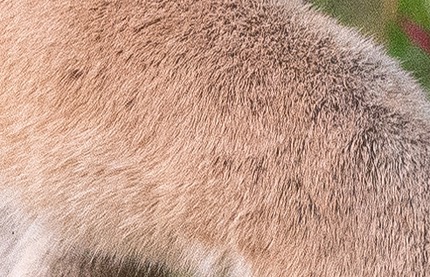You hear the term all the time, what does it mean?
Unfortunately, different things to different people. Consider this sample from an image:

I've run a strong deconvolution sharpening on it without regard to noise propagation so that we can better see if the animal's fur is "in focus." (More on that term, in focus, in a bit.)
No, that sample is not tack sharp. We can kind of make out the individual hairs, but there's not strong edge acuity to them. You should see a small bit of antialiasing blur on them, despite my attempts to "pull the edges in."
How about this part of the same image?

Nope, still not tack sharp. While very close, there's still a bit of small blur to the fine detail, just like before. We're closer here to where we want to be, but not quite there.
How about this one?

Hmm, that looks a little better, doesn't it? The individual hairs have more clear delineation, and you can see exactly how fine and distinct they are at the upper right edge. Actual focus is probably just a bit to the upper left of center on this sample. And that's just a bit forward of the eye position on the animal.
You may have guessed by this point that these samples all come off the same image:

The first sample was on the back of the front shoulder, the second obviously the face, and the third in the middle of the raised leg.
Overall, this 45mp D850 image renders just fine when processed decently (not as much exaggeration as I've used here). Focus is very close to where I wanted it (the eye), but not quite there. Focus is clearly on the front of the animal, and there's very clear depth cues because the back of the animal is not in focus. That depth cue actually helps people say this image is in focus.
Which brings me to "in focus."
I keep encountering other photographers, other Web sites, and even photo editors that will say that something is "in focus" when I can assure you that the focus plane is actually not where it is supposed to be. Often they try to emphasize that by saying those examples are tack sharp (and that's after applying some form of sharpening, as I did ;~).
In the heat of the moment shooting sports and wildlife in particular, you will have a difficult time putting focus dead square where it should be. If you rely upon the automatic tracking focus modes, the camera will also have a hard time putting the focus plane on precisely the same spot of the subject over and over again (and yes, that's despite face and eye detection). I keep seeing sequences posted by others where they say their camera was precisely tracking a subject, but when I look closely at the sequence at 100% view, I can see clear front/back focus shifts on the subject through the sequence.
Hint: when someone shows you sports images, take the time to look at the grass/field and see if you can pinpoint the focus plane and then follow that through the sequence. This is often how I can see the "waver" of the actual focus plane. You can sometimes do this with wildlife photos, too, though the fields animals are in generally are not as consistent and flat as they are in sports, so it can be more difficult to ascertain where the focus actually was.
What we have in most pronouncements of "in focus" is actually another form of "good enough." Between the camera's tracking mechanism, the depth of field, and the tendency on clear action for our eyes to take in the action without regard to focus, some wobble to the focus plane in action sequences is generally tolerable. But to call the results tack sharp would be wrong.
And yes, different cameras produce slightly different results in automatic tracking. I'd say the two best of the bunch right now are the Nikon D5 and the Sony A9. Picking hairs (pardon the pun) between them I'd say the Nikon is a bit more consistent in placement of the focus plane being in the exact right place than the Sony, but I can accept the results from either.
In the Nikon-only world, I'm going to shock you. Here's the order in which I think the automatic focus tracking does the right thing: D5 is best, Z6/Z7 is second, D850/D500 is third, D7500 is fourth, D750 is fifth. But be forewarned, there's another variable here: the D5 is best at finding the focus plane in the first place on moving subjects (one reason the Z6/Z7 come in second). If you can't adapt to EVF lag or get the focus sensors positioned right initially, the D850/D500 would be second, and the Z6/Z7 might slip further than third. The DX cameras do well because they put their focus sensors fully across the screen, and thus compensate for the camera not staying perfectly framed on the subject somewhat better (another reason why the Z6/Z7 are higher than you probably expected).
Canon users are probably shocked that I'm putting both Nikon and Sony ahead of them. The Canon 1DXm2 isn't really much behind the D5/A9. But it's now behind. Indeed, I tend to find that at every level when comparing Canon/Nikon products until we get down to some of the recent consumer cameras, where Canon has deployed dual-pixel focus and Nikon is still using old technology, like the 11-sensor focus system on the D3500.
Now for the kicker (I really feel like I'm a mirrorless promoter today ;~): for static subjects, pretty much all the mirrorless cameras are more precise and consistent in setting their focus plane than the DSLRs. That gets even more pronounced with fast prime lenses, but it applies to landscape work, too. I'd say that if you're shooting static subjects with a mirrorless camera and missing focus, you're doing something wrong. Very wrong.
To me, tack sharp requires three things: (1) the focus plane be where it's supposed to be; (2) a lens of high MTF capability and little or no astigmatism/coma; and (3) a high resolution sensor capable of clearly resolving the detail produced by the first two. Anything less starts to fall into the "good enough" bin.
Thing is, the camera makers are all going up-scale in their offerings, and we've got better gear today than we've ever had. Gear that's capable of making better images than we used to be able to achieve.
That means that we also have to go up-scale with our assessments, too. My definition of tack sharp today is clearly different than it was a decade ago. If you go back and look at the three ingredients I said were needed you'll see why: (1) focus systems have gotten better; (2) lenses have gotten better; and (3) we've gotten higher resolution cameras.
Next time someone uses a term like "in focus" or "tack sharp," ask them to define their terms. If they stumble at doing that or equivocate at all, then I'd say you should be looking for other experts to listen to.
Update: in this article I'm really talking only about focus. As several people pointed out, other factors come into play in making a tack sharp images: camera motion, subject motion, atmospheric conditions, and even things like the quality/impact of the image stabilization system.
